Whats the difference between the different types of stone fruit, like peaches and nectarines? As it turns out, the differences are skin-deep.
As summer approaches, fruit stands fill up with juicy peaches, nectarines, plums, and other stone fruits. But nestled among the fuzzy drupes and familiar favorites, you may spot some lookalikes Fruits that, at first glance, resemble miniature versions of peaches So what are these peach doppelgangers?
Apricots: The Classic Small Peach
The fruit that most closely resembles a small peach is the apricot. Apricots have all the hallmarks of a classic stone fruit:
- Smooth, slightly fuzzy orange skin like a peach
- Sweet, perfumed flesh like peaches and nectarines
- A large pit in the center
But apricots are much smaller, averaging only 2 inches across compared to a peach’s 4-inch girth Their skin leans more yellow-orange than pinkish-peach. The overall shape is a bit flatter as well
So while apricots may pass for peach mini-mes, their flavor is distinct. The taste falls between a tart cherry and honeyed peach. Apricots pack a zingy sweet-tart punch, with juicy texture similar to a plum.
This bright balance of flavors makes apricots ideal for:
- Eating fresh in fruit salads
- Cooking into jams, tarts, and compotes
- Drying into chewy, sweet-tart snacks
In areas like California, apricots ripen from May through July, heralding the start of stone fruit season. Their short seasonal window makes enjoying apricots all the more special.
Pluots: Peach-Plum Hybrids
Another peach doppelganger comes from the laboratory. Pluots are a hybrid cross between plums and apricots bred to exhibit the best traits of both parents. Some varieties lean more towards their plum heritage, while others resemble peaches.
Flavor-wise, pluots strike a balance between plums and peaches. They offer:
- Juicy, aromatic peach-like flesh
- Sweetness tempered by tart plum notes
- Smooth skin with occasional red speckling
Compared to a true peach, pluots tend to be:
- Smaller, ranging from 2-3 inches diameter
- Shaped more oval than round
- Available in a wider range of colors from golden orange to deep red-purple
Overall, pluots deliver peach-like qualities in a petite package. Their high sugar and acid contents make them ideal fresh eating fruits, while some types work well cooked too.
Peach Relatives: Nectarines, Flat Peaches, and Peacots
Several other fruits in the peach family tree could be mistaken for smaller versions of the fuzzy fruit. These include:
Nectarines – Essentially smooth-skinned peaches. The two are genetically almost identical, with nectarines expressing a recessive smooth skin gene. Flavor and uses are comparable to peaches.
Flat peaches – Peach varieties bred to have a flatter, more squat shape. Skin and flesh mirror traditional peaches. Popular in China.
Peacots – Another plum-peach crossbreed like pluots. Tend to be larger and more peach-like than pluots.
While not exact mini-peach duplicates, these fruits offer hints of peachiness in compact form. Their subtler sweet flavors contrast nicely with the bold, juicy tones of true peach varieties.
How to Enjoy Peach Doppelgangers
Part of the fun with peach lookalikes lies in discovering their distinct charm. Here are some ways to enjoy these petite stone fruits:
-
Eat fresh – Best way to appreciate their nuanced natural flavors.
-
Bake into tarts – Their small size works well in single-serve tarts.
-
Make jam – Cook down into sweet-tart jam and preserves.
-
Grill or roast – Enhances caramelized sweetness.
-
Add to salad – Contribute texture and fruity zing.
-
Blend into smoothies – Adds sweetness without overpowering.
So next time you spot what looks like a miniature peach at the market, take a closer peek. You may discover a new summer favorite like apricots, pluots, or other peachy produces. Their smaller stature offers big, complex flavors perfect for diversifying your fruit diet.
Identifying Ripeness in Peach-Like Stone Fruit
Deciphering when peach lookalikes are at their juicy, sweet-tart peak takes some finesse. Here are tips for identifying ripeness:
-
Touch – Ripe fruit will yield slightly when squeezed but retain shape. Too soft means overripe.
-
Look – Skin background color should be more yellow/orange than green. No bruising.
-
Smell – Aromas become sweeter and more perfumed as fruit ripens.
-
Taste – Sample a sliver. It should taste sweet yet still retain some tartness.
Stone fruits stop ripening once picked, so choose those that give slightly to pressure. Let them finish ripening on the counter out of direct sun. Enjoy within a few days for ultimate flavor and texture.
Storing Small Stone Fruits
The petite size of peach doppelgangers makes them delicate and quick to deteriorate. To extend their short lifespan:
-
Store loosely in the refrigerator. The cold environment slows ripening.
-
Place them in a single layer in a shallow container to prevent bruising. Don’t pile.
-
Wash just before eating. Moisture quickens spoilage.
-
For longer storage, freeze sliced fruit in a single layer on a sheet pan, then transfer to bags.
With care, you can enjoy these peach-like jewels for up to a week post-purchase. Savor their sweet-tart goodness while you can!
The Takeaway
While no fruit can quite match the full-figured juiciness of a ripe peach, small lookalikes like apricots and pluots have their own distinct charm. Their petite proportions, sweet-tart flavors, and short seasons give them an allure all their own.
Keep an eye out for these peach doppelgangers at the summer market. Bringing them home lets you enjoy a diversity of stone fruits and discover new favorites. Broadening your fruit horizons opens up new realms of sweet-tart pleasure.
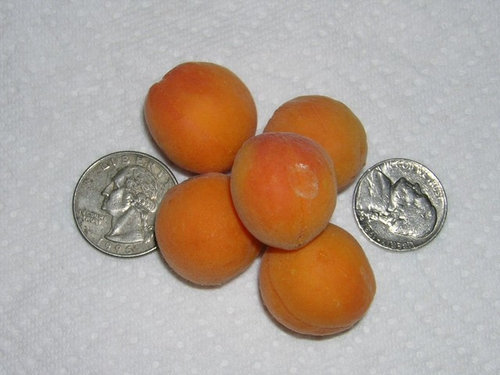
What is stone fruit?
Stone fruit (also known as a drupe) is a variety of fruit that features a stone or pit in the center. The most popular varieties are in the genus prunus, which include peaches, plums and apricots.
Stone fruit isn’t limited to this genus, though. Coconuts, mangos, olives, dates, cashews and coffee are all examples of drupes.

How to Buy Stone Fruit
Don’t squeeze those poor fruits to tell if they’re ripe—you’ll end up bruising them. Instead, give them a whiff. If they smell fragrant, they’re ready to eat! If not, store stone fruit in a paper bag on the counter until that intoxicating smell appears. Once ripened, store stone fruit in the crisper drawer in the fridge.
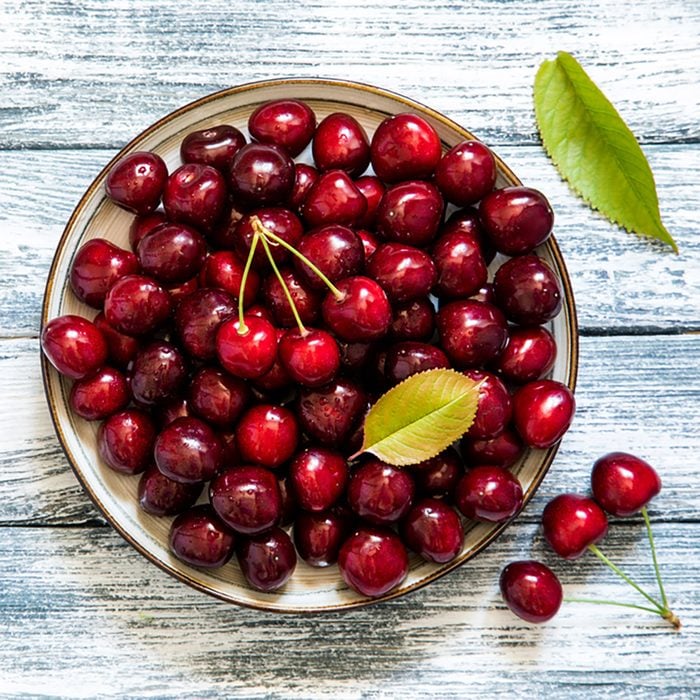
Cherries are the first stone fruit to pop up in the spring, and they’re usually available from April to July. There’s a baffling amount of variety in color and taste, but all cherries are packed full of antioxidants. When it comes to flavor, some cherry varieties are sour, bright and tart while others are firm and sweet.
If you can get your hands on sour cherries, they make the best pies! The sweet varieties are perfect for everything from ice cream to barbecue sauce and jam, including these recipes with fresh cherries. And if you just love making recipes with cherries, make sure you have a cherry pitter to make the job easy.
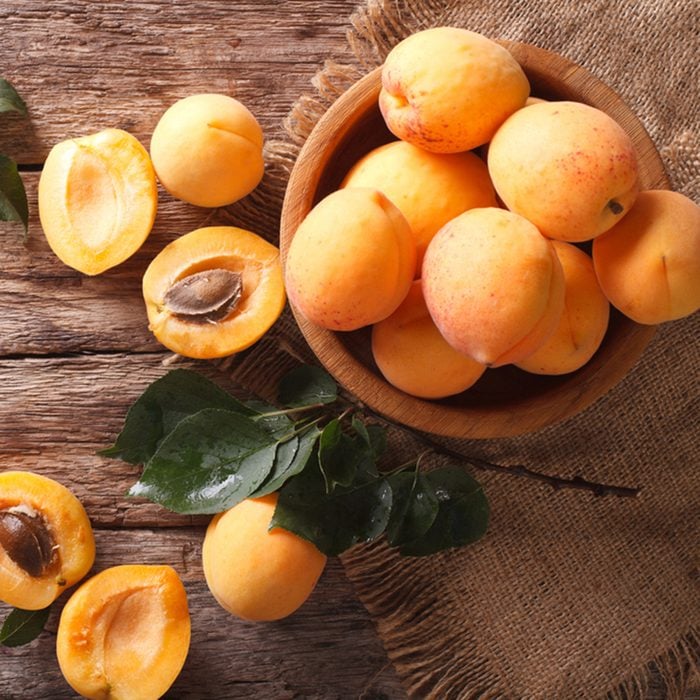
Apricots look like small peaches. They’re rich in beta-carotene and vitamin A, which is beneficial for promoting eye health. They have a tart flavor that’s perfectly balanced by a sweet, creamy texture. They’re usually only available between May and July, and they don’t last very long once they’re picked from the tree—so enjoy them while you can!
Apricots are our go-to fruit for making jam thanks to their pectin-rich skins. They’re also good for dehydrating since they maintain a meaty texture when dried.

You’ll find the traditional fuzzy, heart-shaped peaches with yellow flesh in every grocery store, but you may also find a few different varieties floating around. Donut peaches are flattened and round with low acidity, whereas white peaches are super sweet with a luscious texture. Peaches are available year-round in the grocery store but best enjoyed between May and October. Peach season is short—but if you know how to store peaches, you’ll have juicy, fresh-tasting fruit all year round. For best results, learn how to pick ripe peaches.
In addition to being rich in vitamins and minerals, peaches may also help promote healthy digestion. So pick up a few peaches to add to your favorite summer salad, toss them on the grill to add depth of flavor or use them to make an incredible cobbler or peach pie.

A nectarine looks a lot like a peach and tastes a lot like one too! Nectarines even share the same season, from about May to October. The major difference between the two is that nectarines have smooth skin, as opposed to peach’s fuzzy exterior. They have a slightly firmer texture, but you can use them interchangeably in recipes that call for peaches.
Like peaches, nectarines are rich in vitamins and minerals, especially immune-boosting vitamin C. They’re great on the grill and pair especially well with cheese to create an incredible appetizer crostini. But don’t stop there! Try these juicy nectarine recipes.
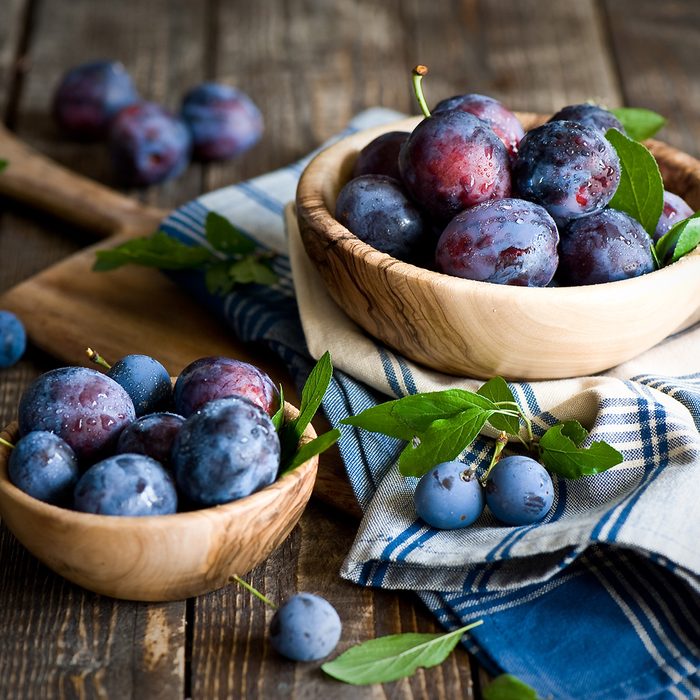
The classic plum is bright purple, but they actually come in all colors. Unlike most other stone fruit, the skin on plums is usually smooth instead of fuzzy. They have super juicy flesh, so make sure you have a napkin handy when eating them raw! They’re usually not ripe until May, but they stay in season all the way until November, so don’t be afraid to add them to your holiday menu.
Our favorite plum recipes involve dessert, but they’re also great on salads or appetizer platters. No matter how you serve plums, you’ll benefit from their nutrients and phytochemicals that help to lower inflammation.
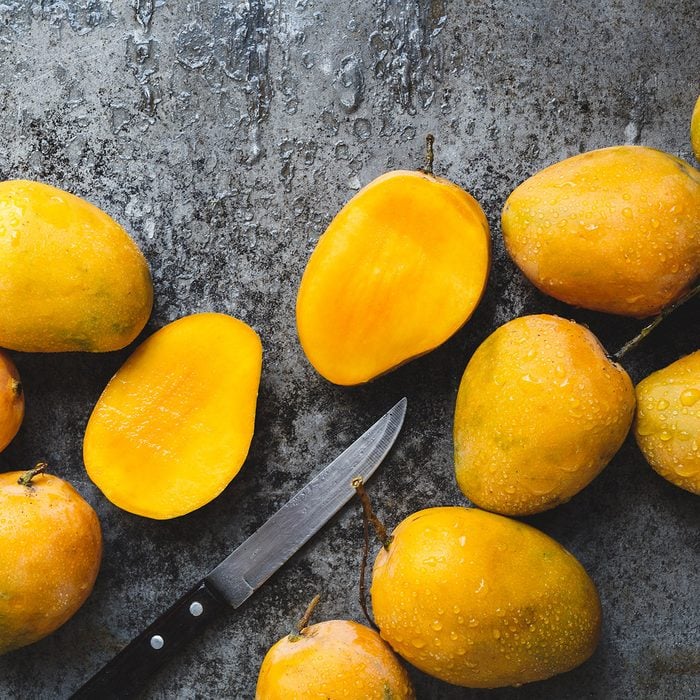
They don’t have a large pit in the center, but mangos are still included on this stone fruit list. Mangos are native to Southeast Asia and grow in other warm climates like Florida, California and Mexico. You can find them in the grocery store year-round, but their peak season is May to October. Like most stone fruit, they’re high in antioxidants, vitamins and essential minerals.
Mango skin has an unpleasant taste, so we recommend peeling it before moving on. The seed can be a little tricky to remove, too, but we have step-by-step instructions that make it much easier. These sweet fruits are a no-brainer for dessert, but they also have a tangy flavor that makes them an excellent choice for savory applications like mango salsa.

Why I have SMALL PEACHES and how to get LARGE peaches
FAQ
What fruit looks like a tiny peach?
Apricots. Apricots look like a smaller version of a peach, about a quarter of the size. They have fuzz on their skin and are similarly shaped and colored. They are not, however, as closely related to a peach as a nectarine is.
What are those small peaches called?
Clingstone peaches
They’re typically smaller, juicy and sweet, and are ideal for getting peach season off to a fresh start. Clingstones are also excellent for canning and preserving, but the effort to get the flesh separated from the seed makes the process a bit more cumbersome.
What does a nectarine taste like?
Nectarines have a sweet, fresh, and tangy taste, with a flavor profile similar to peaches but often with a more pronounced sweetness and a honey-like aroma.
Is stone fruit healthy?
Nutrition: Stone fruits are high in dietary fiber, potassium, vitamin A and vitamin C, which support skin health and the immune system.
